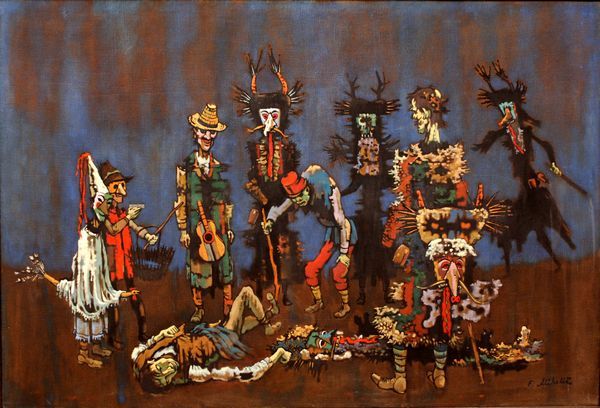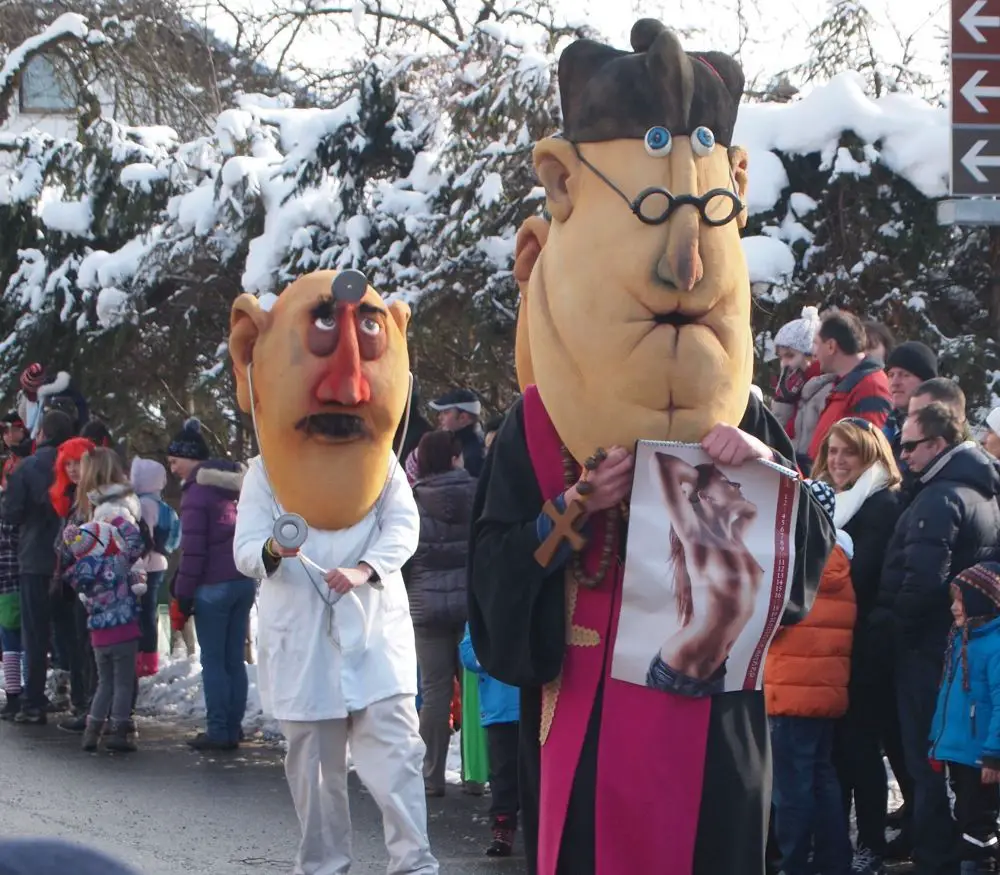January 31, 2018
Pust, carnival, masquerade, a pre-Christian holiday celebrating the end of winter and the beginning of spring, begins this year (2018) on Fat Thursday, February 8, and ends on Ash Wednesday, February 14.
Around 1300 AD the Christian authorities, unable to get rid of them, pushed these traditional pagan festivities into the time before Lent and the 40 days of fasting, when pretty much everyone (except perhaps the head of the house) ate very little, if at all, until Easter.
Pust has long been time of decadence, heavy eating (and drinking), crossdressing and, since the masks mean you have no idea who is who, the opportunity for all sorts of shenanigans, crime included.
The priest of Butale, Cerknica carnival, Ash Wednesday, 2013 Photo: Neža Loštrek

France Mihelič: Mrtvi kurent (Dead kurent), acrylic painting on canvas, Kranj
In the suburbs and countryside (less so in city centres, although you can never be sure), trick or treating is still alive, but do not expect to have a chat with every maškara that shows up on your doorstep, since these figures are not allowed to speak. But give kids who turn up in costume some sweets or a krof (donut), tell them they look super, and don't expect a “thank you” in return. After all, the function of maškara is to scare the winter away, not to show good manners.

Krofi, already sold in some places. (These are from TruBar, a café at the end of the pedestrian zone on Trubarjeva cesta)
Also, in case you have children, make sure to learn on which day(s) they have to come dressed up to their kindergarten or their school, as if you don’t know they may not forgive you that easily.
To get a better picture of what is about to happen, here are some of the events that are expected to take place in the weeks that follow:
Ptuj
Kurentovanje (named after perhaps best known traditional maškara that originates of Ptuj – the kurent, since 2017 on UNESCO’s World Cultural Heritage list) is certainly the number one place to check if you are planning any trips in the following two weeks. Indeed, Ptuj will start its carnival one week ahead of everybody else, as kurenti are very much in demand. Their annual cow bell routine will start on Friday, February 2 at about midnight. For more info, check kurentovanje’s website, which is in English.
Cerknica
Cerknica carnival takes a bit different approach from the one in Ptuj. If we were looking for an overall theme of the Cerknica tradition, we might find it in all possible expressions of political incorrectness. The festival starts with a transition of powers from the City Mayor to the Prince of Pust on Fat Thursday, February 8, and ends on Ash Wednesday, February 14 with the burning of and a funeral for Pust (for this occasion, Pust becomes a puppet in a coffin). The main character of Cerknica carnival is a witch (the big one is called Uršula), as Cerknica, or rather Slivnica, a hill right next to the town, is believed to be a traditional meeting point for witches from all over the country. The group of big headed and quite ugly people called Butalci (after a book), representing various idiotic aspects of Slovenian society and its citizens, is also getting bigger every year in Cerknica. For more click here, and the website is in English.
Ljubljana
Dragon carnival will take place in the streets of the capital on Saturday, February 10 at 11:00. Watch the video below and see what to expect.
San Giorgio, Rezija (Resia, ITA)
A really special place to go, if you have the time, energy and will, is Resia valley on other side of Kanin mountain, where a rather isolated Slovenian minority lives, who developed and retained their own very distinctive and elegant style. Perhaps it is because this valley in the middle of hills and mountains was somewhat overlooked by the 19th century's “birth of nations” and accompanying development of a simpler and more uniform folk culture, that these villagers still dance as the European nobility did in 18th century courts. The main event of Resian carnival will take place in the village’s main square on Sunday, February 11, at 14:00.








